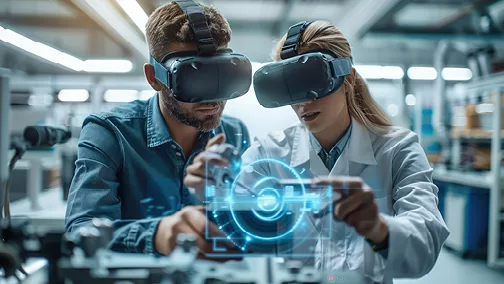In the context of training, Virtual Reality (VR) offers fully immersive experiences by plunging learners into simulated environments. Mixed Reality (MR), which combines virtual elements with the real world, takes this a step further. By adding interactions between the virtual and the real, MR provides new perspectives for more effective, collaborative, and immediately applicable training. With the arrival of new headsets, such as those from Meta and Pico, this technology has also become very financially accessible, facilitating its adoption in the professional environment.
Interaction with the real environment: a learning experience rooted in reality.
Unlike VR, which isolates the learner in a completely virtual world, MR allows for the integration of digital elements within the real environment. The learner can still see, hear, and interact with their physical surroundings while receiving additional information through virtual elements.
In the field of training, this translates into situations where a learner can use real tools while following instructions displayed in mixed reality. For example, a trainee electrician can manipulate a real distribution board while seeing virtual visual cues appear regarding the various steps to follow or safety points to check. This continuity between the virtual and the real allows for better skill acquisition, as the learner is in direct contact with the objects they will use in their professional daily life.
Collaborating in real-time on training tasks.
One of the main advantages of mixed reality (MR) over virtual reality (VR) is the ability for multiple users to interact together on the same virtual object while remaining grounded in their physical environment. This enables a seamless collaborative approach.
Let’s take the example of training in industrial maintenance. Multiple technicians can be in the same room and simultaneously observe a virtual model of the machine they are learning to repair. Each technician can propose actions, test procedures, or discuss solutions to be adopted while seeing the adjustments made in real time. This type of collaboration, enhanced by mixed reality (MR), allows learners to work together effectively and interactively, sharing a common object of study.
Using physical objects while integrating virtual data
One of the aspects that fundamentally differentiates mixed reality (MR) from virtual reality (VR) is the ability to interact with physical objects while receiving virtual data. In MR, the learner can more easily use real tools or equipment while being guided by real-time virtual information.
For example, during an automotive maintenance training session, a learner can manipulate a real engine while seeing virtual information projected onto the various parts. This information can include assembly instructions, technical diagrams, or specific points of attention. This allows for a smooth integration of theory and practice, providing training that is both realistic and instructive.
Remote assistance: the expert at your fingertips.
Another major advantage of mixed reality is the ability to integrate real-time remote assistance from an expert. With mixed reality, a trainer or expert can monitor the learner’s actions live and provide precise guidance without being physically present.
For example, in an industrial equipment maintenance training, a remote expert can observe, through a video stream, what the learner sees through their mixed reality glasses. They can then directly annotate the image perceived by the learner, point out specific areas of the machine, or provide verbal and visual instructions to correct an error or guide the learner through a complex procedure. This ability to receive personalized assistance in real-time without being on-site is a significant advantage for training, especially when qualified human resources are limited.
Enhancing immersion while staying connected to the real world.
Unlike VR, where the user is completely disconnected from their physical environment, mixed reality maintains a connection to it, which is essential in certain training scenarios where interaction with real equipment or colleagues is necessary.
In a fire safety training scenario, for example, the learner can see virtual flames appearing in a real physical environment while having access to guidance on the actions to take, risks to avoid, or the proper use of a fire extinguisher. Learning occurs in complete immersion, but within an environment that remains grounded in the learner’s professional reality, providing a better transition to real-world situations.
Real-time feedback for continuous adaptation.
Mixed reality (MR) also allows for immediate and contextual feedback. During training, learners can receive advice, alerts, or corrections in real-time, directly integrated into their environment. This enhances hands-on learning by helping learners correct their actions without interrupting their workflow.
Take the case of a welding training: if the learner makes a technical mistake, mixed reality (MR) can instantly display corrective indications directly on the piece being worked on, such as guide lines or messages indicating poorly welded areas. This immediate feedback, based on real actions, helps reinforce learning through experience.
By allowing simultaneous interaction with real and virtual objects, mixed reality (MR) not only anchors learning in the reality of the work environment but also enhances collaboration and provides real-time remote assistance. For training that requires handling real equipment or facilitating exchanges between teams, MR emerges as a flexible, realistic, and immediately applicable technology.

